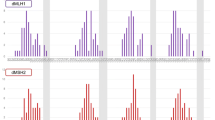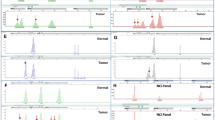Abstract
Purpose
Stratifying patients defective in mismatch repair (dMMR) with high microsatellite instability (MSI-H) in colorectal cancer (CRC) is of increasing relevance and may provide a more tailored approach to CRC adjuvant therapy. Here, we describe the discovery of a new MSI marker for colorectal cancer located in the 3′-untranslated region (3′UTR, T20 mononucleotide repeat) of the metallothionein 1X gene (MT1XT20).
Methods
We studied 340 consecutive CRCs using three multiplexed polymerase chain reactions amplifying BAT25, BAT26, TGFBR2, MybT22, BAT40, MT1XT20, NR21, NR24, CAT25, D2S123, D5S346, D17S250, D18S58, CSF1PO, D7S820, and D18S51. Fragments length was evaluated by automated capillary electrophoresis.
Results
Based on the NCI/ICG-HNPCC criteria for MSI classification, 40 CRCs were found to be MSI-high (11.8%), 46 (13.5%) CRCs were MSI-low, and 254 CRCs (74.7%) were stable (MSS). MT1XT20 showed very high sensitivity (97.3%) comparable to BAT26 (97.5%) and CAT25 (97.1%) and the best specificity (100%) as well as MybT22 and CAT25. Indeed, MT1XT20 instability was detected in 36 out of 37 cases (97.3%) of MSI-high colorectal cancers, whereas no MT1XT20 alterations were observed in 254 MSS or in 46 MSI-low cases. On the contrary, BAT40 was found to be unstable in 8/46 MSI-low cases, BAT25 in 6/46, BAT26 4/46, NR21 1/46, and NR24 in 1/45.
Conclusions
Our results suggest that MT1XT20 represents a sensitive and specific marker for MSI testing and could be included in a complete set of MSI markers for the confident identification of familial or sporadic dMMR patients in CRCs.



Similar content being viewed by others
Abbreviations
- dMMR:
-
Defective mismatch repair
- MSI-H:
-
High microsatellite instability
- CRC:
-
Colorectal cancer
- MT1XT20:
-
3′UTR T20 mononucleotide repeat of the metallothionein 1X gene
- MSI-L:
-
Low microsatellite instability
- MSS:
-
Microsatellite stability
- NCI/ICG-HNPCC:
-
National Cancer Institute/International Collaborative Group-Hereditary Non-Polyposis Colorectal Cancer
- AJCC/UICC:
-
American Joint Cancer Committee/Union Internationale Contre le Cancer
- FFPE:
-
In formalin fixed and paraffin embedded
- H&E:
-
Haematoxylin and eosin
- LOH:
-
Loss of heterozygosity
References
Umar A, Risinger JI, Hawk ET, Barrett JC (2004) Testing guidelines for hereditary non-polyposis colorectal cancer. Nat Rev Cancer 4(2):153–158. doi:10.1038/nrc1278
Thibodeau SN, Bren G, Schaid D (1993) Microsatellite instability in cancer of the proximal colon. Science 260(5109):816–819
Smyrk TC, Watson P, Kaul K, Lynch HT (2001) Tumor-infiltrating lymphocytes are a marker for microsatellite instability in colorectal carcinoma. Cancer 91(12):2417–2422. doi:10.1002/1097-0142(20010615)91:12<2417::AID-CNCR1276>3.0.CO;2-U
Kim H, Jen J, Vogelstein B, Hamilton SR (1994) Clinical and pathological characteristics of sporadic colorectal carcinomas with DNA replication errors in microsatellite sequences. Am J Pathol 145(1):148–156
Lothe RA, Peltomaki P, Meling GI, Aaltonen LA, Nystrom-Lahti M, Pylkkanen L, Heimdal K, Andersen TI, Moller P, Rognum TO et al (1993) Genomic instability in colorectal cancer: relationship to clinicopathological variables and family history. Cancer Res 53(24):5849–5852
Rodriguez-Moranta F, Castells A, Andreu M, Pinol V, Castellvi-Bel S, Alenda C, Llor X, Xicola RM, Jover R, Paya A, Bessa X, Balaguer F, Cubiella J, Arguello L, Morillas JD, Bujanda L (2006) Clinical performance of original and revised Bethesda guidelines for the identification of MSH2/MLH1 gene carriers in patients with newly diagnosed colorectal cancer: proposal of a new and simpler set of recommendations. Am J Gastroenterol 101(5):1104–1111. doi:10.1111/j.1572-0241.2006.00522.x
Gryfe R, Kim H, Hsieh ET, Aronson MD, Holowaty EJ, Bull SB, Redston M, Gallinger S (2000) Tumor microsatellite instability and clinical outcome in young patients with colorectal cancer. N Engl J Med 342(2):69–77. doi:10.1056/NEJM200001133420201
Samowitz WS, Curtin K, Ma KN, Schaffer D, Coleman LW, Leppert M, Slattery ML (2001) Microsatellite instability in sporadic colon cancer is associated with an improved prognosis at the population level. Cancer Epidemiol Biomarkers Prev 10(9):917–923
Carethers JM, Smith EJ, Behling CA, Nguyen L, Tajima A, Doctolero RT, Cabrera BL, Goel A, Arnold CA, Miyai K, Boland CR (2004) Use of 5-fluorouracil and survival in patients with microsatellite-unstable colorectal cancer. Gastroenterology 126(2):394–401
Ribic CM, Sargent DJ, Moore MJ, Thibodeau SN, French AJ, Goldberg RM, Hamilton SR, Laurent-Puig P, Gryfe R, Shepherd LE, Tu D, Redston M, Gallinger S (2003) Tumor microsatellite-instability status as a predictor of benefit from fluorouracil-based adjuvant chemotherapy for colon cancer. N Engl J Med 349(3):247–257. doi:10.1056/NEJMoa022289
Sargent DJ, Marsoni S, Monges G, Thibodeau SN, Labianca R, Hamilton SR, French AJ, Kabat B, Foster NR, Torri V, Ribic C, Grothey A, Moore M, Zaniboni A, Seitz JF, Sinicrope F, Gallinger S (2010) Defective mismatch repair as a predictive marker for lack of efficacy of fluorouracil-based adjuvant therapy in colon cancer. J Clin Oncol 28(20):3219–3226. doi:10.1200/JCO.2009.27.1825
Boland CR, Thibodeau SN, Hamilton SR, Sidransky D, Eshleman JR, Burt RW, Meltzer SJ, Rodriguez-Bigas MA, Fodde R, Ranzani GN, Srivastava S (1998) A National Cancer Institute Workshop on Microsatellite Instability for cancer detection and familial predisposition: development of international criteria for the determination of microsatellite instability in colorectal cancer. Cancer Res 58(22):5248–5257
Umar A, Boland CR, Terdiman JP, Syngal S, de la Chapelle A, Ruschoff J, Fishel R, Lindor NM, Burgart LJ, Hamelin R, Hamilton SR, Hiatt RA, Jass J, Lindblom A, Lynch HT, Peltomaki P, Ramsey SD, Rodriguez-Bigas MA, Vasen HF, Hawk ET, Barrett JC, Freedman AN, Srivastava S (2004) Revised Bethesda Guidelines for hereditary nonpolyposis colorectal cancer (Lynch syndrome) and microsatellite instability. J Natl Cancer Inst 96(4):261–268
Agostini M, Enzo MV, Morandi L, Bedin C, Pizzini S, Mason S, Bertorelle R, Urso E, Mescoli C, Lise M, Pucciarelli S, Nitti D (2010) A ten markers panel provides a more accurate and complete microsatellite instability analysis in mismatch repair-deficient colorectal tumors. Cancer Biomark 6(1):49–61. doi:10.3233/CBM-2009-0118
Findeisen P, Kloor M, Merx S, Sutter C, Woerner SM, Dostmann N, Benner A, Dondog B, Pawlita M, Dippold W, Wagner R, Gebert J, von Knebel DM (2005) T25 repeat in the 3′ untranslated region of the CASP2 gene: a sensitive and specific marker for microsatellite instability in colorectal cancer. Cancer Res 65(18):8072–8078. doi:10.1158/0008-5472.CAN-04-4146
Murphy KM, Zhang S, Geiger T, Hafez MJ, Bacher J, Berg KD, Eshleman JR (2006) Comparison of the microsatellite instability analysis system and the Bethesda panel for the determination of microsatellite instability in colorectal cancers. J Mol Diagn 8(3):305–311. doi:10.2353/jmoldx.2006.050092
Suraweera N, Duval A, Reperant M, Vaury C, Furlan D, Leroy K, Seruca R, Iacopetta B, Hamelin R (2002) Evaluation of tumor microsatellite instability using five quasimonomorphic mononucleotide repeats and pentaplex PCR. Gastroenterology 123(6):1804–1811. doi:10.1053/gast.2002.37070
Goel A, Nagasaka T, Hamelin R, Boland CR (2010) An optimized pentaplex PCR for detecting DNA mismatch repair-deficient colorectal cancers. PLoS One 5(2):e9393. doi:10.1371/journal.pone.0009393
Watanabe T, Wu TT, Catalano PJ, Ueki T, Satriano R, Haller DG, Benson AB 3rd, Hamilton SR (2001) Molecular predictors of survival after adjuvant chemotherapy for colon cancer. N Engl J Med 344(16):1196–1206. doi:10.1056/NEJM200104193441603
Cherian MG, Jayasurya A, Bay BH (2003) Metallothioneins in human tumors and potential roles in carcinogenesis. Mutat Res 533(1–2):201–209
Giacomini CP, Leung SY, Chen X, Yuen ST, Kim YH, Bair E, Pollack JR (2005) A gene expression signature of genetic instability in colon cancer. Cancer Res 65(20):9200–9205. doi:10.1158/0008-5472.CAN-04-4163
Aebi S, Fink D, Gordon R, Kim HK, Zheng H, Fink JL, Howell SB (1997) Resistance to cytotoxic drugs in DNA mismatch repair-deficient cells. Clin Cancer Res 3(10):1763–1767
Mayer F, Gillis AJ, Dinjens W, Oosterhuis JW, Bokemeyer C, Looijenga LH (2002) Microsatellite instability of germ cell tumors is associated with resistance to systemic treatment. Cancer Res 62(10):2758–2760
Sammalkorpi H, Alhopuro P, Lehtonen R, Tuimala J, Mecklin JP, Jarvinen HJ, Jiricny J, Karhu A, Aaltonen LA (2007) Background mutation frequency in microsatellite-unstable colorectal cancer. Cancer Res 67(12):5691–5698. doi:10.1158/0008-5472.CAN-06-4314
Hoang JM, Cottu PH, Thuille B, Salmon RJ, Thomas G, Hamelin R (1997) BAT-26, an indicator of the replication error phenotype in colorectal cancers and cell lines. Cancer Res 57(2):300–303
Zhou XP, Hoang JM, Li YJ, Seruca R, Carneiro F, Sobrinho-Simoes M, Lothe RA, Gleeson CM, Russell SE, Muzeau F, Flejou JF, Hoang-Xuan K, Lidereau R, Thomas G, Hamelin R (1998) Determination of the replication error phenotype in human tumors without the requirement for matching normal DNA by analysis of mononucleotide repeat microsatellites. Gene Chromosome Canc 21(2):101–107. doi:10.1002/(SICI)1098-2264(199802)21
Perucho M (1999) Correspondence re: C.R. Boland et al., A National Cancer Institute workshop on microsatellite instability for cancer detection and familial predisposition: development of international criteria for the determination of microsatellite instability in colorectal cancer. Cancer Res., 58:5248–5257, 1998. Cancer Res 59(1):249–256
Mead LJ, Jenkins MA, Young J, Royce SG, Smith L, St John DJ, Macrae F, Giles GG, Hopper JL, Southey MC (2007) Microsatellite instability markers for identifying early-onset colorectal cancers caused by germ-line mutations in DNA mismatch repair genes. Clin Cancer Res 13(10):2865–2869. doi:10.1158/1078-0432.CCR-06-2174
Biswas S, Trobridge P, Romero-Gallo J, Billheimer D, Myeroff LL, Willson JK, Markowitz SD, Grady WM (2008) Mutational inactivation of TGFBR2 in microsatellite unstable colon cancer arises from the cooperation of genomic instability and the clonal outgrowth of transforming growth factor beta resistant cells. Genes Chromosome Canc 47(2):95–106. doi:10.1002/gcc.20511
Bacolod MD, Barany F (2011) Molecular profiling of colon tumors: the search for clinically relevant biomarkers of progression, prognosis, therapeutics, and predisposition. Ann Surg Oncol. doi:10.1245/s10434-011-1615-5
Acknowledgements and funding
This study was supported in part by a regional grant (1897, 2008) given by Friuli Venezia Giulia to Alphagenics Diaco Biotechnologies S.r.l., Area Science Park, Basovizza, Trieste Italy. DdB is founded by CIRC (Centro Interdipartimentale di Ricerca sul Cancro, University of Bologna).
Competing interests
Luca Morandi declares that he has applied for a patent relating to the content of this manuscript. Adriana Monzoni is affiliated with Alphagenics Diaco Biotechnologies S.r.l. and is full-time employed. The other authors indicated no potential conflicts of interest.
Author information
Authors and Affiliations
Corresponding author
Electronic supplementary material
Below is the link to the electronic supplementary material.
ESM
MSI status in detail for our series: sheet 1 (MSI-high) is a list of all 40 MSI-H specimens; sheet 2 (MSI-low) is a list of all 46 MSI-L specimens. MSI microsatellite instability, MSS microsatellite stability, LOH loss of heterozygosity, AI allelic imbalance, NA not available (XLS 59 kb)
Rights and permissions
About this article
Cite this article
Morandi, L., de Biase, D., Visani, M. et al. T[20] repeat in the 3′-untranslated region of the MT1X gene: a marker with high sensitivity and specificity to detect microsatellite instability in colorectal cancer. Int J Colorectal Dis 27, 647–656 (2012). https://doi.org/10.1007/s00384-011-1365-7
Accepted:
Published:
Issue Date:
DOI: https://doi.org/10.1007/s00384-011-1365-7




